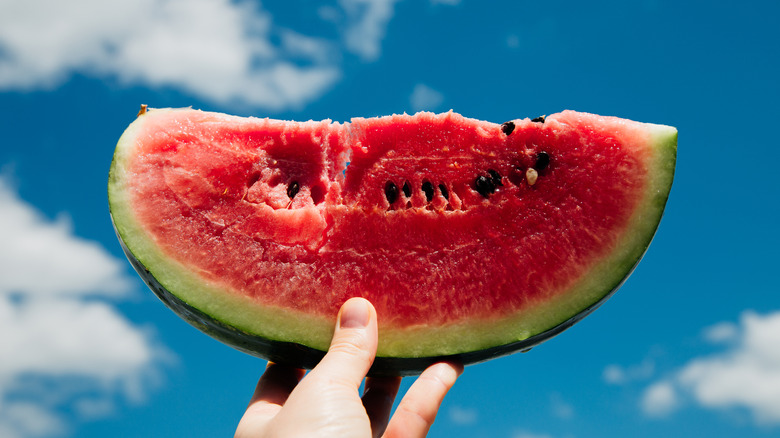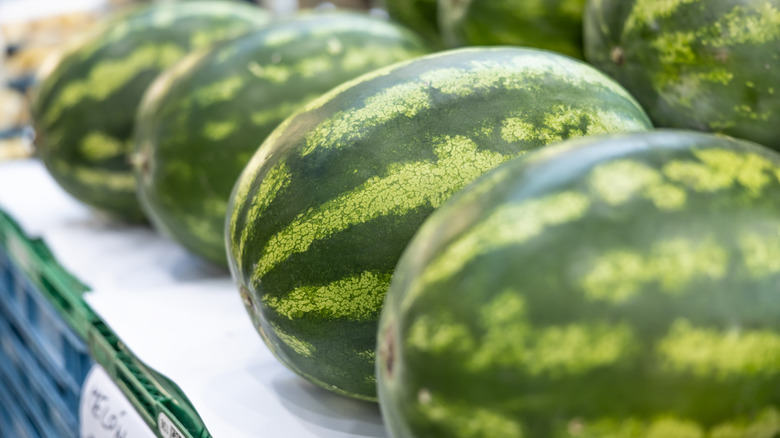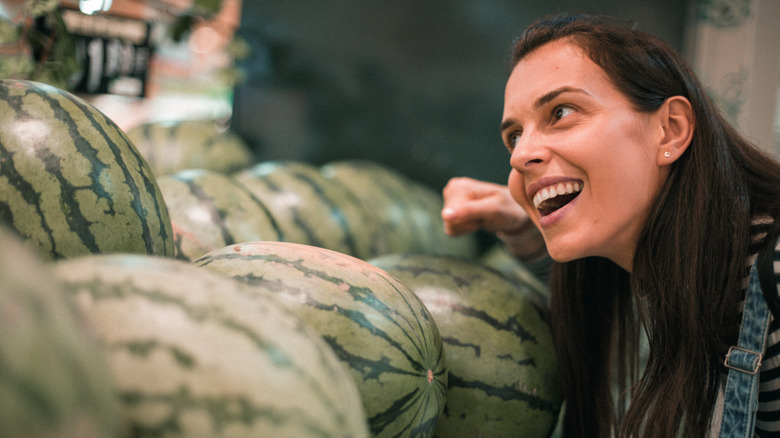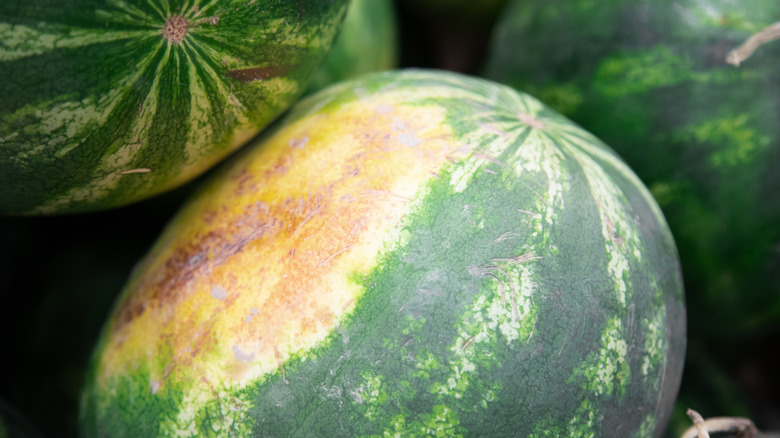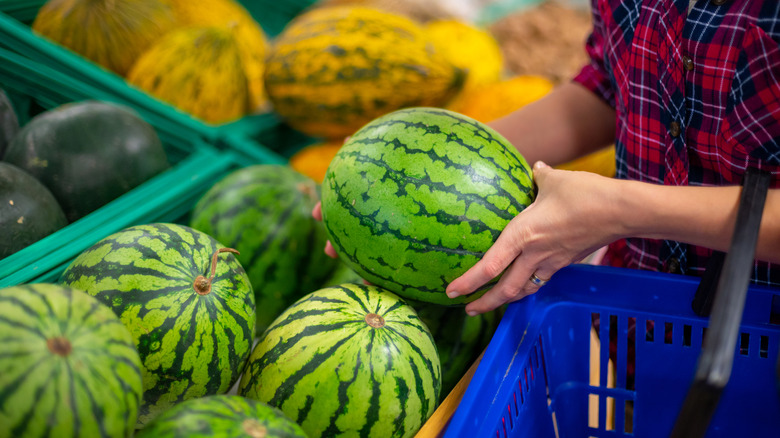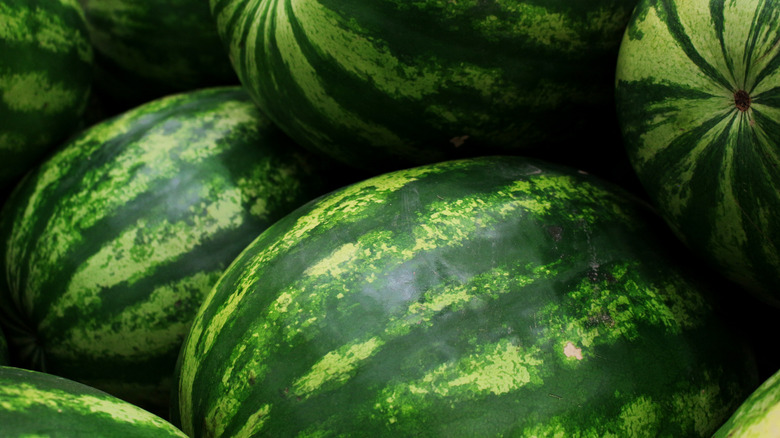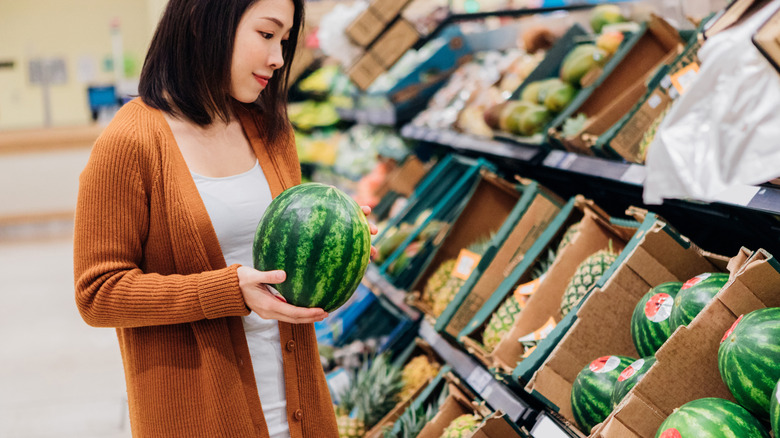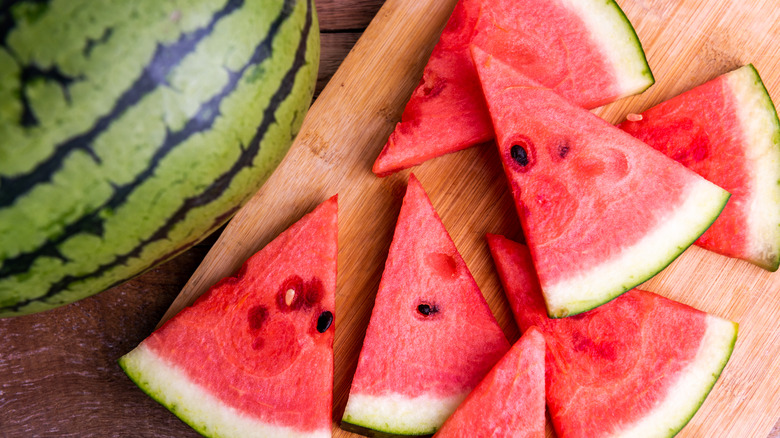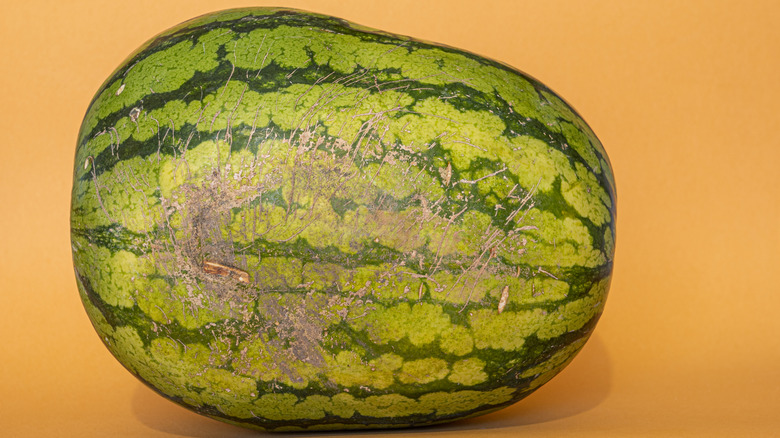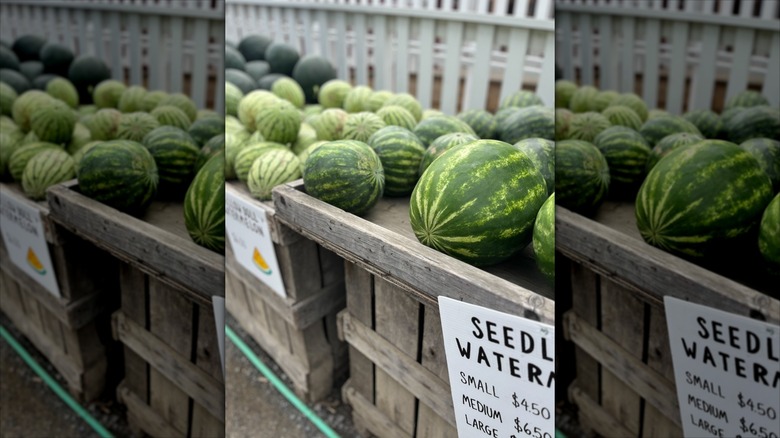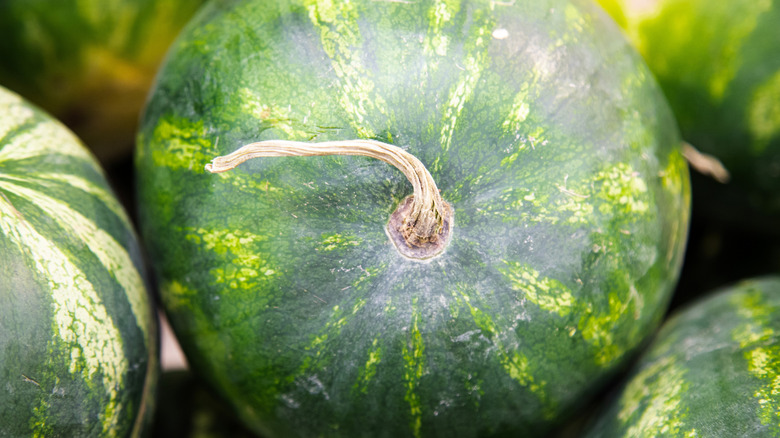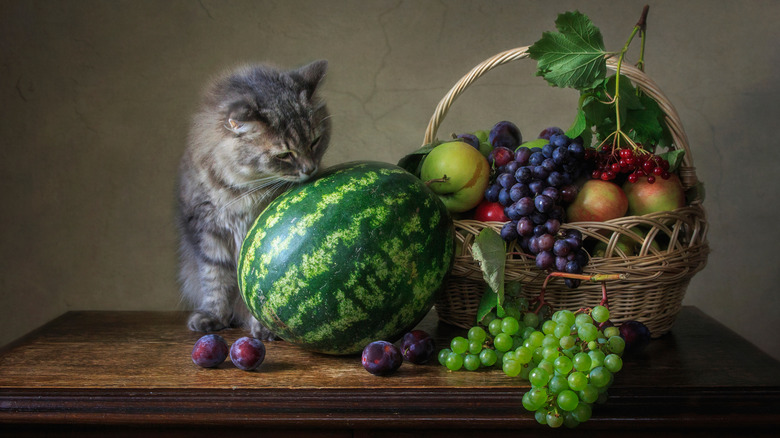11 Tricks For Buying The Perfect Watermelon You'll Wish You Knew Sooner
There's nothing like a good watermelon — sweet, juicy, and with a flavor that's distinctly its own. But, how many times do you pick one up from the supermarket thinking it's going to be delicious, only to bring it home and find it watery or insipid? Luckily, it doesn't have to be like that; there are plenty of tips and tricks for choosing a perfectly ripe watermelon.
It might seem like there's no way to tell if one is ripe from the outside, but this is one of the mistakes everyone makes with watermelons. There's no need to resign yourself to sad fruit plates, because it's totally possible to know if these melons are good or not from a number of telltale signs. Make use of most of your senses (you'll have to save taste for when you cut it open) to evaluate a watermelon before you take it home from the store. You can give it a whack and listen, feel it, look at it, and even smell it to find out what it's like inside.
Armed with these 11 tricks for buying the perfect watermelon, you can guarantee yourself a summer full of tasty fruit. Whether you're making a watermelon salad, grilling it, or just chowing down on a big slice, juice dripping down your face, learning these tricks will mean you're never disappointed with your choice.
1. Use your fingers to measure the stripes on a watermelon
A good watermelon should have clearly defined dark green and pale green or white stripes. That's perhaps the first thing you should look out for, avoiding those with pale or ill-defined stripes. However, you might not know that the distance between these stripes matters. And that gives you a simple way to check whether a watermelon is ripe.
You can pick out a ripe watermelon every time with this two-finger trick. All you need to do is use your index and middle fingers to measure the distance between the stripes. You should be able to fit at least two fingers in the dark green areas between the pale stripes. Nobody seems to know why this trick works, but it does. And it seems to have been confirmed by multiple watermelon farmers, too.
Now, this doesn't necessarily mean that all watermelons with less than two fingers worth of space between pale stripes are tasteless. Rather, it means that most watermelons that pass the two-finger test are ripe and delicious. So it's a good way of making sure you pick out a fruit that's juicy and at its best. And the thing about watermelons is that they don't ripen off the vine, so you need to make sure they're good right away.
2. Thump a watermelon and listen
It might seem unusual to go to a store and thump a watermelon. What did it ever do to you? But this is one of the ways you can tell if a watermelon is good. You can use your ears to help you decide whether it's one that you should take home or leave in the produce aisle.
So, find a watermelon that looks good and knock on the side. What you're listening out for is a hollow or bouncy sound. If it sounds dull or muted, then it probably isn't good. This technique doesn't necessarily tell you about the ripeness of the melon, but rather if the flesh has any bruising or damage inside. Of course, this can be somewhat subjective and it can take a while to get a feel for it. So, to start off, you may want to use this technique in conjunction with others on this list.
The other thing to remember is not to whack it too hard. Just a gentle knock should do the trick. If you use too much force, you may end up damaging the watermelon, leaving it bruised. So, whoever ends up taking it home will be left with a subpar fruit. Still, once you get the hang of this technique, it's a quick and easy way to find a decent watermelon.
3. Look at the color of the field spot
Have you ever noticed that watermelons often have a discolored patch on them? It looks like an area where the color just didn't take. Well, this is known as a field spot and it's where the watermelon was touching the ground while it was growing. It ends up colorless because no sunlight reaches it. A bit like the way that houseplants can yellow if they don't get enough light.
Now, because you can't ripen a watermelon that isn't ready yet, you need to look out for any sign you can that tells you it's good to eat. And one of these is the color of the field spot. A good watermelon should have a buttery yellow color. This means it was left in the field until it was fully mature. If the spot is white, it indicates that the melon was picked before it was totally ripe.
We love how simple this technique is. All you need to do is give the watermelon a quick glance and you'll see whether or not it's ripe. As with all these tips and techniques, they aren't always totally correct. We've had some watermelons with paler spots that tasted great and some with yellow spots that could have been better. However, a yellow field spot in conjunction with another sign of ripeness will usually leave you with something tasty.
4. Feel the watermelon for firmness
Of all the ways to pick a good watermelon, feeling for firmness might not seem like the most flashy or advanced trick but it's one of the most useful. Sure, techniques like knocking and in-depth examining of the color or stripes get all the attention, but don't underestimate what your hands can tell you.
Pick up a watermelon and give it a gentle squeeze. You don't need to squeeze it hard — you don't want to bruise or damage it — just use enough pressure to feel the give of the rind. What you want is firmness with just the tiniest bit of bounce. Too hard, and it might not be ripe yet. Too soft or spongy, and it could be overripe or even starting to rot inside. There's a sweet spot here, and once you've felt a few, it gets easier to spot.
Also, run your fingers across the surface. A healthy watermelon should have a consistent texture and be free from soft spots, dents, or wrinkled patches. Any of those are signs of internal damage, which means disappointment when you cut it open.
Like most watermelon-checking techniques, this one isn't foolproof on its own. But combine it with a solid field spot and a good knock, and you've got a pretty reliable read. Trust your hands. They've probably handled enough produce to know what feels right, even if you haven't consciously noticed it before.
5. Check for an even shape
When you're sizing up a watermelon, its shape is a clue about how the fruit developed. Look for one that's uniform and symmetrical, whether it's round or oval. What you don't want is anything lopsided, misshapen, or bulging on one side.
An uneven shape usually means the melon didn't grow uniformly. It might've gotten inconsistent water or sunlight, or maybe it developed too fast in one direction. That kind of wonky growth often leads to texture issues. You can end up with mealy or stringy flesh in some areas, or pockets that just don't taste right. A watermelon that's grown steadily and evenly is more likely to be consistent all the way through.
Pay attention to any sharp ridges or flat spots too. Minor markings are normal, but if one side looks flattened or concave, that could point to internal bruising. Of course, perfect spheres aren't required. Although some oval watermelons have a flesh-to-rind ratio that's a little off, one that's naturally this shape can be just as good as a round one. You may just want to make sure the shape is balanced and the surface is smooth.
6. Search for a heavy watermelon
You should never eat unripe watermelon — not because it's dangerous but just because it doesn't taste good, and nobody needs that kind of disappointment. One of the quickest ways to gauge a watermelon's ripeness is to just lift it up. A ripe, juicy watermelon should feel surprisingly heavy for its size. That's because it's packed tight with water and sugar.
It should be easy to tell whether a watermelon feels heavier than you'd expect, but if you're unsure, try picking up a few that are roughly the same size. The one that feels the heaviest is probably the ripest. That weight means the fruit is full of liquid and developed properly on the vine. If it feels oddly light, it might be airy or mealy. It could have not developed properly or it could be old and dehydrated.
You're not necessarily looking for the biggest watermelon in the bin here. A small watermelon that feels dense and hefty is a much better choice than a giant one that seems weirdly airy. It's hard to explain exactly what you're looking for in words, but easy to feel once you've done it a few times. You might feel a little self-conscious picking up and comparing all the watermelons in the store, but it will be worth it when you take the perfect one home.
7. Avoid shiny watermelons
Glossy might be great for apples, but for watermelons, shiny is a red flag. A ripe watermelon should have a dull, matte skin. That dullness is a sign the fruit has fully matured on the vine and is therefore sweet, juicy, and ripe.
Shiny-skinned watermelons, on the other hand, tend to be underripe. They were likely picked too early, before the sugars had a chance to develop and the flesh could reach its peak deliciousness. Bite into it and it might end up tasting watery and lacking in flavor. A sore disappointment when you're craving a good watermelon.
The difference can be subtle, especially under the bright lights of a grocery store, so it helps to compare a few side by side. If one has a muted, almost chalky finish and another is gleaming like it's just been waxed, go for the dull one every time. But that doesn't mean the rind should look dry or shriveled. You're still looking for healthy color and clear striping if it has any, but without the reflective sheen.
It's not the flashiest trick but it's a sign that's easy to spot once you know to look for it. And while it's not the most talked-about watermelon tip, it's one that can quietly steer you away from bland slices and toward something with real flavor.
8. Look for spots and webbing
At first glance, those scuffed-looking spots and brown web-like marks on a watermelon's skin might seem like blemishes. But don't be too quick to pass them over. The secret to buying a perfectly ripe watermelon can be looking for the ugliest one in the store.
Webbing is the name for those tan or brown rough patches that look like a network of veins. Primarily, these are formed during pollination. Every time a bee touches the flower of the watermelon plant, it leaves a tiny scar on the fruit it eventually turns into, and the more scars you see, the more visits that melon got. More pollination means better sugar development, which usually leads to sweeter fruit.
You might also see small sugar spots. These are darkened areas or crusty-looking patches where sugar has started to seep out of the rind. That might sound unappealing, but it's a good sign that the melon inside is high in natural sugars. These spots can be sticky to the touch, almost like a light residue.
Of course, there's a line between sweet-looking webbing and signs the fruit has been damaged. Skip melons with deep cracks, mold, or areas that look like they've caved in. But if the skin is firm and the webbing is shallow, don't let a few rough spots scare you off. Some of the best-tasting watermelons are the ones that look worse for wear.
9. Buy watermelons from a farm stand
If you've ever lugged home a supermarket watermelon only to slice into a pale, watery disappointment, you're not alone. The issue isn't just bad luck, it's the nature of how grocery store melons are grown and shipped.
Commercial growers harvest watermelons en masse, often picking them before they're fully ripe to ensure they survive long-distance transport. Sure, they're left until they're almost ripe, but they're not quite there. They can be sweet, but one left to ripen fully on the vine — like those found at local farm stands — tends to be juicier and sweeter, while retaining that crispness.
Farm stand watermelons are grown for flavor, not for their ability to endure a cross-country journey. They're more likely to be picked at peak ripeness, so they're more likely to have that incredible, distinct watermelon flavor in abundance.
Next time you're craving watermelon, consider skipping the supermarket and heading to a local farm stand. Yes, you have to go out of your way and you're not going to be able to pick up all your groceries at the same time, but the flavor just doesn't compare. Plus, you're supporting a small farmer and you get to have the cute experience of rocking up to a farm stand in a rural area rather than enduring the bright lights of a grocery store. It's just a better time all round.
10. Take a look at the stem
When selecting a watermelon, the stem can tell you a little something about its ripeness. It's an easy place to look to give you an indication of whether it's going to be juicy and delicious or pale and watery. So, what are you looking for with the stem?
A dry, brown stem typically indicates that the melon got enough time to ripen on the vine. It spent long enough on there that the vine started to dry out before it was picked. This suggests that the fruit has developed its full sweetness and flavor. A green, firm stem shows that the watermelon was picked prematurely. This means it wouldn't have had enough time to reach its optimal sweetness and it might be lacking in flavor.
Occasionally, you might encounter watermelons without any stem attached. This could mean the fruit naturally detached from the vine upon ripening, which is a good sign. In this case, it was left to mature absolutely and you'll have an extremely tasty watermelon on your hands. However, it's also possible that the stem was removed during handling, so you should look for other signs of ripeness to go alongside it.
11. Use your nose
While not everyone thinks to sniff a watermelon before buying it, your nose can be a useful tool when you're hunting for a ripe one. Like other fruits, a ripe watermelon should give off a subtle sweet scent. You might find it's more noticeable near the blossom end, which is the opposite side from where the stem was attached.
You're not necessarily looking for anything overpowering. In fact, if a watermelon smells overly fermented or sour, that could be a sign it's too far gone. What you want is a light scent. It's a bit like the smell of fresh-cut melon but more delicate. It develops as the fruit reaches peak ripeness, when its natural sugars are most concentrated. And that's why it's a sign that the fruit is particularly ripe.
The smell test works best when the melon is at room temperature. Chilled watermelons don't release as much scent, so if you're picking one out of a cold bin, you might not detect much. Try smelling a few different ones side by side. If one stands out with a sweet, fruity aroma while the others smell like nothing at all, that's the one to go for. It's normally a sign that the flesh will be sweet and juicy.
